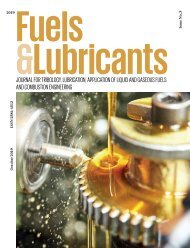Fuels & Lubricants Magazine
Issue No. 3, October 2018
Issue No. 3, October 2018
You also want an ePaper? Increase the reach of your titles
YUMPU automatically turns print PDFs into web optimized ePapers that Google loves.
mm 2 /s, authors [4] attempted to extrapolate<br />
the coefficient α to other oil<br />
viscosities as well. The results are on<br />
Pictures 4 and 5. Picture 4 shows the<br />
correlation between viscosity-pressure<br />
coefficient α and kinematic<br />
viscosity of these oils at 200 MPa.<br />
Picture 5 shows the same correlation<br />
at 600 MPa. Both charts are valid for<br />
the temperature range 25 – 80 °C.<br />
Figure 4: Pressure coefficient at 200 MPa<br />
N - naphtenic oil<br />
SI - silicone oil<br />
M - paraffinic mineral oil<br />
PAO - polyalfaolefine oil<br />
ES - ester oil<br />
PG - polyalkyleneglycol oil<br />
MPa are PG, Ester or PAO synthetic<br />
oils. Paraffinic mineral oil is worse<br />
and naphtenic is the worst.<br />
All these oils were measured the<br />
same way as paraffinic mineral oil<br />
in Figure 3, but as there are not any<br />
data about solidification, it is issued<br />
only brief description based of high<br />
viscosity measurement.<br />
The best was polyglycol oil with<br />
KV40°C = 100 mm 2 /s. Its viscosity<br />
400 000 mPa.s was reached at 500<br />
MPa for oil temperature 26.8 °C.<br />
The pressure 800 MPa increased<br />
the viscosity only to 20 000 mPa.s at<br />
70.2 °C. The worst was silicone oil<br />
with KV 40 °C = 120 mm 2 /s, which<br />
reached viscosity 400 000 mPa.s<br />
already at half pressure than PG oil<br />
– at 250 MPa (and at 26.8 °C). The<br />
higher temperature = 70.1 °C improves<br />
its behaviour to get viscosity<br />
400 000 mPa.s at 430 MPa.<br />
Following the Picture 3 it is possible<br />
to estimate the curve of paraffinic<br />
mineral oil with KV40 °C = 9.62<br />
mm 2 /s. The shape and slope of this<br />
curve will be similar as the curve belongs<br />
to the temperature 37 °C, but<br />
the starting point is shifted down to<br />
10 1 mPa.s, it can be calculated more<br />
exactly as 8.40 mPa.s. The solidification<br />
point deducted from the chart is<br />
at 520 MPa.<br />
Figure 5: The same chart for 600 Mpa<br />
Literature Data Discussion<br />
The lowest viscosity-pressure<br />
coefficient at normal conditions (see<br />
Picture 4) shows very low viscosity<br />
silicone oil, but there are doubts<br />
about its very high pressure behavior,<br />
especially when higher viscosity<br />
silicone oils have really enormous<br />
steep slope of viscosity-pressure<br />
relationship. This is strange, because<br />
generally all other oils show<br />
the higher is viscosity index, the<br />
lower is coefficient α. It is confirmed<br />
by Stepina [2] as well. Maybe the<br />
structure based on Si-O exhibit<br />
different relationship. Nevertheless<br />
the lubricating properties of low<br />
viscosity silicone oil or even silicone<br />
solvent are poor and that is why it is<br />
impossible to recommend it for this<br />
expensive apparatus.<br />
Following the Picture 5 the best<br />
candidates for the range of temperatures<br />
25 °C – 80 °C and pressure 600<br />
Data Comparison and<br />
Evaluation<br />
The temperature of actually used<br />
transformer oil was 30 °C, kinematic<br />
viscosity was 13.7 mm 2 /s (12.0<br />
mPa.s) at that temperature. Solidification<br />
Point from the chart (Figure 3)<br />
is at 490 MPa, if it would be paraffinic<br />
oil. See Figure 6. As the transformer<br />
oil is naphtenic origin, then lower<br />
pressure can be expected to cause<br />
solidification. 420 – 460 MPa is expected<br />
pressure which cause solidification<br />
of transformer oil at 30 °C.<br />
This value is in a very good agreement<br />
with experiment. The pressure<br />
interval between 420 – 500 MPa is<br />
caused by increasing temperature<br />
<strong>Fuels</strong>&<strong>Lubricants</strong> No. 3 OCTOBER 2018 7







